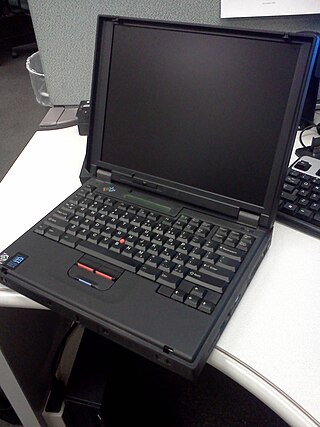
The PowerBook G3 is a series of laptop Macintosh personal computers designed, manufactured, and sold by Apple Computer from 1997 to 2001. It was the first laptop to use the PowerPC G3 (PPC740/750) series of microprocessors, and was marketed as the fastest laptop in the world for its entire production run. The PowerBook G3 was succeeded by the PowerBook G4.
The Hitachi Flora Prius was a range of personal computers marketed in Japan by Hitachi, Ltd. during the late 1990s.

The Compaq Presario 1200 was a line of notebook computers produced between 1998 and 2000 by Compaq as part of Compaq Presario line.

The IBM ThinkPad 380 was a notebook computer series released May 13, 1997 by IBM as part of their ThinkPad laptop series. Notable for incorporating a CD-ROM and a floppy drive, it was considered a mid-range laptop by IBM at the time, and sold well. The series was the successor to the IBM ThinkPad 365.

The Personal Computer Series, or PC Series, was IBM's follow-up to the Personal System/2 and PS/ValuePoint. Announced in October 1994 and withdrawn in October 2000, it was replaced by the IBM NetVista, apart from the Pentium Pro-based PC360 and PC365, which were replaced by the IBM IntelliStation.
The Kay 1024 was a Russian ZX Spectrum clone introduced in 1998. Created by the NEMO company of St. Petersburg, it has 1024 KB of RAM. It was a rival to Scorpion ZS 256, having a slightly lower price. It offered a controller for a PC keyboard and HDD, but not for floppy disks. Adding a General Sound card was easy, and the CPU had a 7 Mhz turbo mode.

The history of laptops describes the efforts, begun in the 1970s, to build small, portable Personal Computers that combine the components, inputs, outputs and capabilities of a Desktop Computer in a small chassis.

The PS/2 E or Energy is a member of the IBM Personal System/2 family of personal computers (PCs). It was the first Energy Star-compliant PC, consuming very little power relative to other contemporary PCs, and made extensive use of recycled materials in its enclosure.

IBM ThinkPad 310 was a notebook computer series introduced in 1997 by the IBM corporation into the market as part of their ThinkPad laptop series. It was succeeded by the ThinkPad 380 series.

IBM ThinkPad 770 was a laptop designed and manufactured by IBM targeted for the business, enterprise and professional user. It was the last lineup in the ThinkPad 700-series, succeeding the 760 as the high-end laptop of the ThinkPad lineup. The line was produced from October 1997 to May 2000, and eventually replaced by the ThinkPad models A20m and A20p.
The Sony Vaio 700 series were Sony's first Vaio branded laptops, starting with the 705 and 707 models, launched in Japan on July 1, 1997, and subsequently in the United States.

IBM ThinkPad 240 is an ultra-portable laptop computer designed and produced by IBM from June 1999 to 2001. It is one of the few ThinkPad 200 series models made available in America and was the smallest and lightest ThinkPad model produced to date. The 240 series was discontinued, and it was replaced with the ThinkPad X series in 2000.

The IBM ThinkPad 600 series was a series of notebook computers introduced in 1998 by IBM as an lighter and slimmer alternative to the 770 series. Three models were produced, the 600, 600E, and 600X; the series was succeeded in 2000 by the ThinkPad T20 series.

The IBM ThinkPad T20 series was a series of notebook computers introduced in May 2000 by IBM as the successor of the 770 series and the first model of the T-series which exists today under Lenovo ownership. Four models were produced, the T20, T21, T22, and T23; the series was succeeded in May 2002 by the ThinkPad T30, but was produced until July 2003.

The IBM ThinkPad 365 is a notebook computer series developed by IBM and manufactured by ASE Group. It was released in North America in November 1995, and was the successor of the ThinkPad 360 series. The series had 8 models that were released before being discontinued, and was succeeded in 1997 by the ThinkPad 380 series.

The IBM Thinkpad 350 series was a notebook computer series introduced in 1993 by IBM as part of their Thinkpad laptop series. It was the successor to the IBM ThinkPad 300. With only 2 models ever made in the series, it was succeeded in 1994 by the IBM Thinkpad 360 series.

The IBM ThinkPad 360 series was a notebook computer series introduced in 1994 by IBM as part of their ThinkPad laptop series. It was succeeded in late 1995 by the IBM ThinkPad 365 series.
Armada is a discontinued line of business laptops by Compaq. They started as a more affordable version of the Contura line, but after that, they replaced Contura as a mainstream laptop line, and then the high-end Compaq LTE line were merged with Armada as a premium 7300 and 7700 sub-lines.

The Personal System/2 Model 30 and Personal System/2 Model 30 286 are IBM's entry-level desktop computers in their Personal System/2 (PS/2) family of personal computers. As opposed to higher-end entries in the PS/2 line which use Micro Channel bus architecture, the Model 30 features an Industry Standard Architecture bus, allowing it to use expansion cards from its direct predecessors, the PC/XT and the PC/AT. The original PS/2 Model 30 is built upon the Intel 8086 microprocessor clocked at 8 MHz; the Model 30 286 features the Intel 80286 clocked at 10 MHz.
The CF-V21P is a notebook-sized laptop released by Panasonic in 1993. It was the first notebook computer to have an integrated CD-ROM drive as an option, albeit it only supports up to 3.5-inch-diameter mini CDs instead of standard 4.7-inch-diameter discs. It was discontinued in 1994.

















